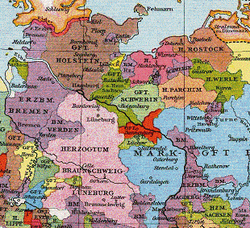County of Dannenberg Grafschaft Dannenberg | |||||||
|---|---|---|---|---|---|---|---|
| 1153–1303 | |||||||
 The county (in red) around 1250 | |||||||
| Status | State of the Holy Roman Empire | ||||||
| Capital | Dannenberg | ||||||
| Government | Feudal county | ||||||
• 1153–1166 | Volrad I | ||||||
• 1289–1303 | Nicholas | ||||||
| Historical era | Middle Ages | ||||||
• Established | 1153 | ||||||
• Disestablished | 1303 | ||||||
| |||||||
| Today part of | Germany | ||||||
The County of Dannenberg (German: Grafschaft Dannenberg) was a fief in the Duchy of Saxony. Its heartland was largely identical with the present-day collective municipality of Elbtalaue in north Germany.
Its historical origins go back to the middle of the 12th century, when Henry the Lion founded the five counties of Holstein, Ratzeburg, Schwerin, Dannenberg and Lüchow during the Ostsiedlung, or colonisation of the East, from the mouth of the River Elbe to the southern border of the March of Brandenburg, in order to protect the new regions and borders of his territory.[1]
The County of Dannenberg is first mentioned in the records in 1153; its first count, until 1169, was Volrad I of Dannenberg. He came from a noble family, the Edlers of Salzwedel. The county lasted until 1303, when the last count, Nicholas of Dannenberg, relinquished all his rights between the Elbe and Jeetzel rivers to Duke Otto the Strict, and it is finally mentioned in the records in 1311.[2]